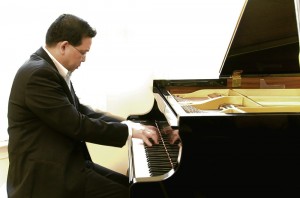
Under conductor Olivier Ochanine, the PPO was in top form, essaying a well-thought-out program that called for introspection rather than dramatic flair.
Featured soloist was Filipino pianist Ariel Francisco Dechosa, who is based in Maryland, US.
The program consisted of Ravel’s orchestration of “Le Tombeau de Couperin,” a Baroque work Ravel set in modern idiom, consisting of the first four movements of the suite. This was followed by Beethoven’s Concerto No. 4 in G Major for Piano and Orchestra, Op. 58, and concluded with Schumann’s Symphony No. 2 in E Minor, Op.27.
The program richly disclosed contrasting stylistic idioms that called for intelligent playing, a task Ochanine and the PPO eloquently met. In the opening Ravel number, Ochanine had ventured into an unfamiliar symphonic sound, which defied the usual drama of an overture as an opener.
Hushed tones were etched with arresting elegance, upholding precision and balance of the classical style Couperin infused his work with. The bubbling zest of the Baroque dance came in arresting wit expressed in beautifully crafted lines.
Ochanine was meticulous to the last detail, ensuring dynamic precision and tonal fluidity. Reynato “Dondon” Resurreccion played the oboe passages marvelously.
In the Beethoven concerto, Ochanine and Dechosa forged a powerful tandem tightly held by mutual capability. Both knew their respective metier, and eloquently expressed a singular
In command
Dechosa struck a hefty voiced meditative passage in the opening, which Ochanine and the PPO answered in an unhurried, hushed tone. Brilliance was the order of playing and both orchestra and piano sang with utmost lyricism.
If Dechosa was in command, so was conductor Ochanine. In a restrained manner, Dechosa carved out singing lines that Ochanine, who was in complete command of the orchestra, matched with equal verve.
Dechosa eloquently played the cadenza which broke the earlier contemplative mood, waking up, so to speak, the mesmerized listeners to listen to brilliant closure of the first movement.
In the second movement, the conversation between the piano and orchestra was carried out with pleasant ardor. The hymn-like passage intoned by the orchestra was answered by the meditative incantation the pianist exquisitely played.
Throughout, one heard a dialogic interplay of brilliance and quietude between the piano and orchestra. The latter defied; the former resigned in full contemplation. One listened in awe unmindful of the tears that unabashedly streamed down the cheeks.
In the cadenza and coda of the last movement, both piano and orchestra broke the quiet ambiance into a dynamic brilliance that brought the piece to an end. Dechosa displayed dynamic virtuosity, crowning his playing with brilliant pianism.
In awe
Lush symphonic sound was heard in the Schumann opus. Ochanine wielded his baton authoritatively, carving out a buoyant first movement; an infectious, playful second movement; a reflective third movement; and a majestic fourth movement.
Truly, the concert was a revelation for the youthful conductor, who has to be listened to more: vibrant, intelligent, and convincingly musical.
The audience burst into deafening applause.
At the lobby strains of Anderson’s “Christmas Festival” were heard. The festive Yuletide sounds made one realize it was already Christmas, indeed, a moment for rejoicing!